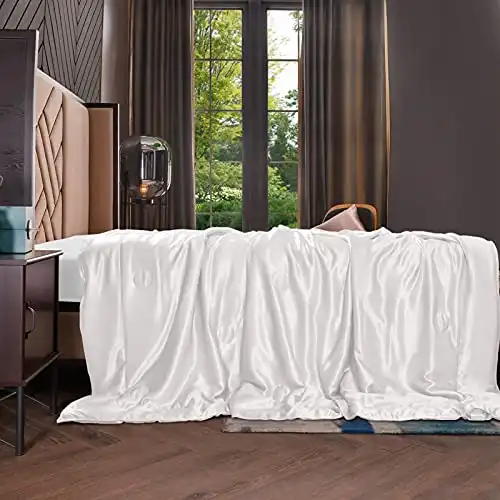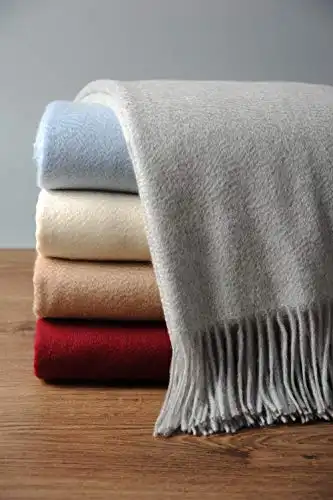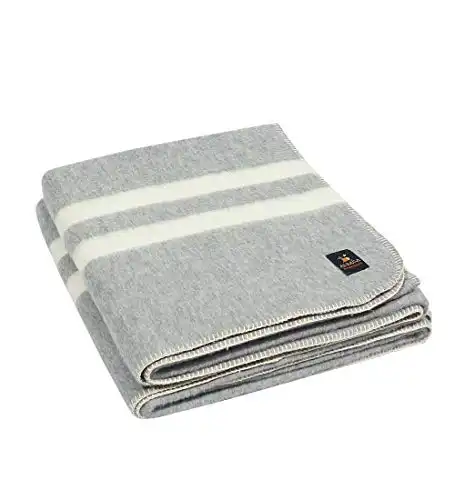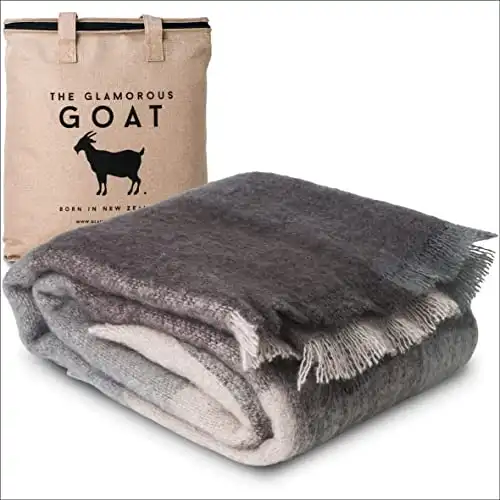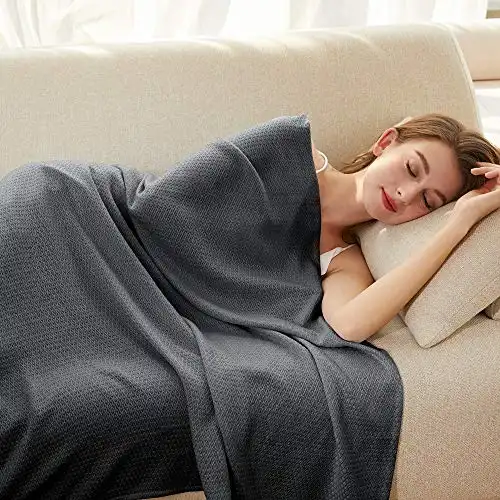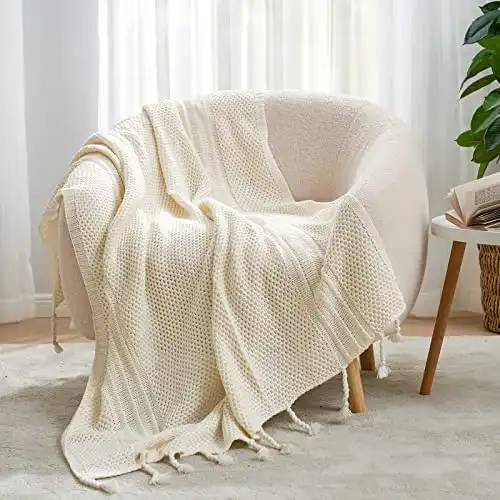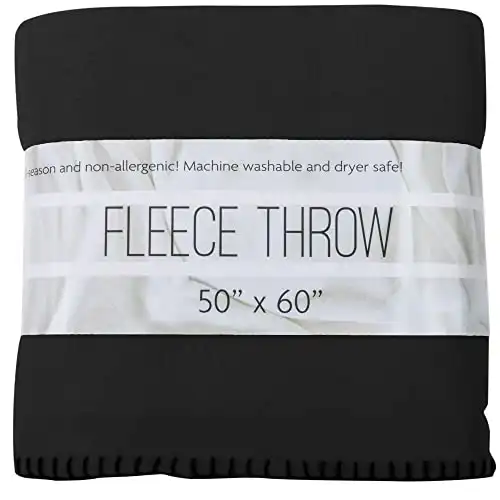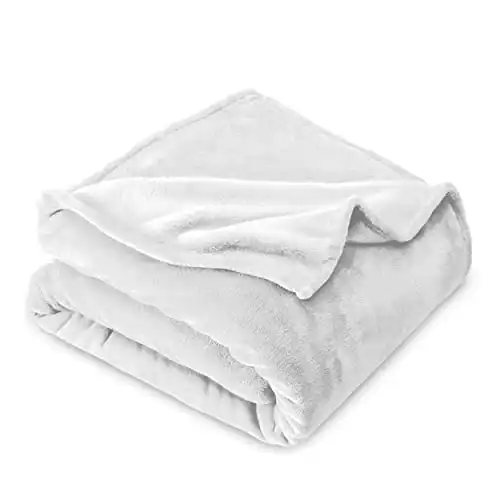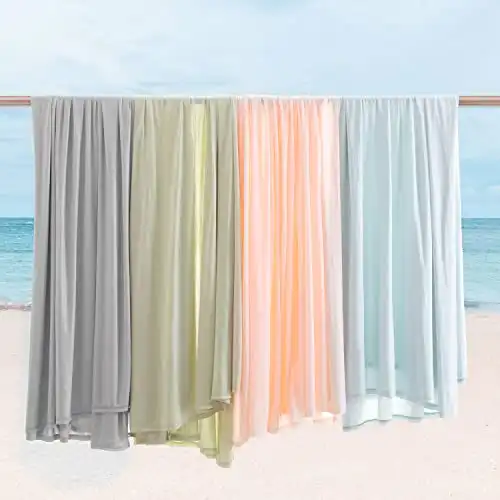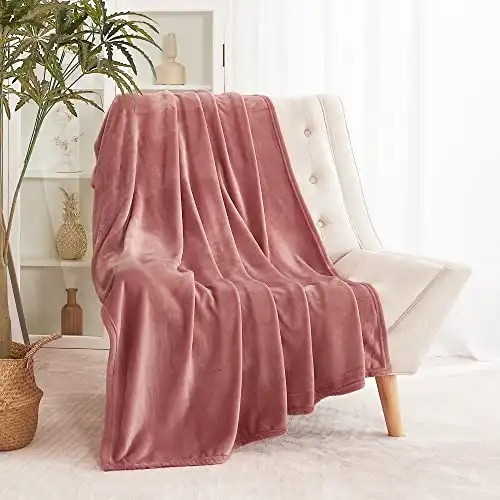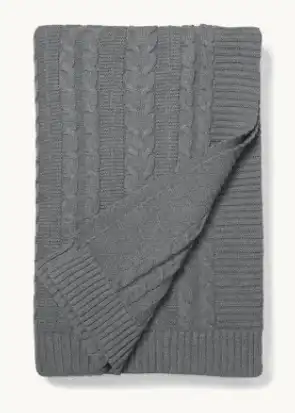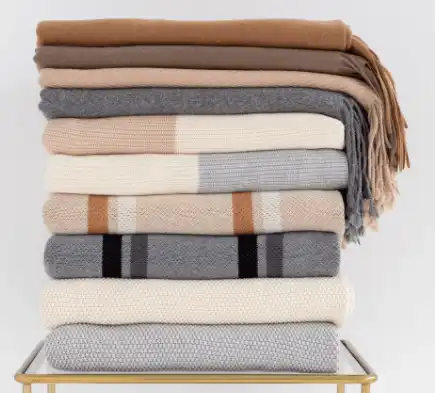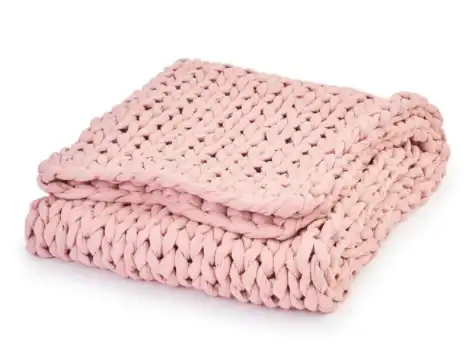- You are here:
- Home »
- Organic Bedding »
- Natural vs. Synthetic Blanket Materials: Which One is Right for You?
Natural vs. Synthetic Blanket Materials: Which One is Right for You?
Blankets are an essential part of our lives, providing warmth, comfort, and a cozy feeling on cold nights. With so many different materials available, choosing the right blanket can be a daunting task. Natural materials like cotton and wool have been used for centuries, while synthetic materials like polyester, fleece, and microfiber have gained popularity in recent years.
Each type of material has its own unique characteristics and benefits, as well as potential drawbacks. In this article, we will explore the different types of blanket materials, their pros and cons, and how to choose the best one for your needs.
Whether you’re looking for a warm and cozy blanket for winter or a lightweight one for summer, understanding the different types of materials will help you make an informed decision.
Natural Blanket Materials:
Wool
Wool is a natural insulator, meaning it’s great at trapping heat and keeping you warm. It’s also got moisture-wicking properties, which means it can absorb moisture without feeling damp.
Wool blankets are durable and long-lasting, and they tend to be heavier and more substantial than some other materials. However, wool can be scratchy and irritating to sensitive skin, and washing wool blankets needs special care.
Pros: Warm, moisture-wicking, durable, long-lasting.
Cons: Scratchy, requires special care when washing.
Cotton
Cotton is a lightweight and breathable material that’s easy to care for. It’s soft and comfortable against the skin and is less likely to cause irritation than wool. Cotton blankets come in a variety of weaves and thicknesses, so you can choose the right one for your needs. Nevertheless, cotton is not as warm as wool or other materials, so it may not be the best choice for colder climates.
Pros: Lightweight, breathable, easy to care for, soft.
Cons: Not as warm as other materials.
Silk
Silk is a luxurious and lightweight material obtained from the cocoons of some insect larvae. It’s soft and smooth against the skin and has a beautiful natural sheen. Silk blankets are hypoallergenic, so they won’t trigger skin rash and other types of allergies. However, silk is not very durable and requires special care when washing.
Pros: Luxurious, lightweight, hypoallergenic, beautiful.
Cons: Low durability, requires special care when washing.
Cashmere
Cashmere is a soft and luxurious type of wool that’s warm and lightweight. It’s made from the soft undercoat of cashmere goats and is known for its softness and warmth. Cashmere blankets are also hypoallergenic and naturally moisture-wicking. On the other hand, cashmere is expensive and requires special care when washing.
Pros: Soft, warm, lightweight, hypoallergenic.
Cons: Expensive, requires special care when washing.
Alpaca
Sizes: King (110" x 92"), Queen (95 x 92”), Twin (82 x 62”)
Alpaca is a soft and warm type of wool obtained from South American alpacas. It’s naturally hypoallergenic and moisture-wicking and known for its softness and durability.
Like all types of wool, Alpaca is also naturally flame-resistant, making it a good choice for blankets. However, alpaca wool blankets are more expensive than regular wool and may require special care when washing.
Pros: Soft, warm, durable, hypoallergenic, flame-resistant.
Cons: Expensive, may need special care when washing.
Mohair
Mohair is a soft and silky type of wool, similar to cashmere. It’s made from the hair of Angora goats and is known for its softness and warmth. During winter, you’ll feel as if you’re cocooned in warmth thanks to its remarkable insulation properties. Additionally, it wicks away any moisture to keep you cool even when temperatures rise during summertime.
On top of that, this fabric is incredibly durable and resilient and won’t crease easily. The price of mohair blankets can be quite expensive due to its luxurious nature, but the quality and comfort you get can be worth it.
Pros: Soft, warm, hypoallergenic, flame-resistant.
Cons: Expensive, requires special care when washing.
Bamboo
Bamboo is a soft, lightweight material that’s becoming more popular for blankets. It’s a sustainable and eco-friendly material that’s also naturally antimicrobial, which means it helps keep bacteria and odors at bay.
Bamboo blankets are also moisture-wicking and breathable, perfect for hot sleepers and warm climates. However, bamboo can be prone to pilling and may not be as warm as other materials.
Pros: Sustainable, eco-friendly, antimicrobial, moisture-wicking, breathable.
Cons: Prone to pilling, may not be as warm as other materials.
Synthetic Blanket Materials
Acrylic
Acrylic is a synthetic material that’s often used as a wool substitute. It’s lightweight and soft, and it comes in a variety of colors and patterns. Acrylic blankets are also easy to care for and are often machine washable. However, acrylic can be less warm than natural materials and may not be as durable.
Pros: Lightweight, soft, easy to care for, comes in a variety of colors and patterns.
Cons: Less warm than natural materials, may not be as durable.
Fleece
Fleece is a synthetic polyester fiber material known for its softness and warmth. It’s often used in blankets and outerwear and comes in a variety of colors and patterns. Fleece blankets are also lightweight and easy to care for, making them a popular choice for outdoor activities.
There are also polar fleece blankets, which much thicker and warmer than regular fleece. Nevertheless, fleece does not allow for the same level of airflow as more natural fabrics and can make you overheat and sweat.
Pros: Soft, warm, lightweight, easy to care for, available in a variety of colors and patterns.
Cons: Not as breathable, can be less comfortable.
Read More: Fleece vs. Wool Blankets
Microfiber
Microfiber is a synthetic material made from polyester and nylon fibers. It’s known for its softness and durability and is often used in bedding and clothing. Microfiber blankets are also hypoallergenic and offer good insulation.
Nevertheless, the comfort of microfiber can vary depending on the quality, so it’s important to check the label before buying.
Pros: Soft, durable, moisture-wicking, quick-drying.
Cons: Not as breathable, can lead to overheating.
Rayon
Rayon is a semi-synthetic material that’s made from natural fibers like wood pulp. It’s popular due to its softness and drape and is often used in clothing and bedding. Rayon blankets are moisture-absorbent and breathable, making them a good choice for warmer weather. However, rayon can only be dry-cleaned and may not be as durable as natural materials.
Pros: Soft, drapey, moisture-absorbent, breathable.
Cons: May require special care when washing, may not be as durable as natural materials.
Sherpa
Sherpa is a synthetic material that’s often used as a lining for fleece blankets and jackets. It’s soft and fluffy and provides excellent insulation. Sherpa is also lightweight and easy to care for, making it a popular choice for outdoor gear. On the other hand, sherpa blankets may not be as durable as natural materials and can be prone to shedding.
Pros: Soft, fluffy, excellent insulation, lightweight, easy to care for.
Cons: May not be as durable as natural materials, can be prone to shedding.
Velvet
Velvet is a synthetic material that’s known for its softness and luxurious feel. It’s often used in blankets and clothing and comes in a variety of colors and patterns.
Velvet blankets are lightweight and their softness and affordability make them a popular choice for bedding. However, velvet may not be as durable as other materials and can be prone to snagging and piling.
Pros: Soft, luxurious feel, lightweight, easy to care for, comes in a variety of colors and patterns.
Cons: Not as durable as other materials
Why Should You Choose a Blanket Made of Natural Materials?
Here are some reasons why it’s best to choose a natural blanket material:
- Breathability: Natural blankets are known for their breathability, which allows air to circulate and prevents you from overheating while you sleep.
- Temperature Regulation: Natural materials like wool have the ability to regulate your body temperature, keeping you warm in the winter and cool in the summer.
- Hypoallergenic: Many natural blanket materials, such as cotton and wool, are hypoallergenic and less likely to cause allergic reactions, such as skin rash.
- Eco-Friendly: Natural materials are biodegradable and renewable, making them a more sustainable choice compared to synthetic materials. They also don´t contribute to microplastic pollution like synthetic materials.
- Durability: Natural materials are often more durable and long-lasting compared to synthetic materials, meaning you can enjoy your blanket for many years. Especially organic certified cotton is stronger than non-organic fabrics because its fibers have not been bleached and treated with chemicals.
- Comfort: Natural materials are soft and comfortable, and often get softer with each wash.
- Chemical-Free: Natural materials are often free of harmful chemicals and dyes, making them a healthier option for you and the environment. Buying organic blankets with GOTS certificate guarantees that the materials used in production were produced without harmful chemicals. Also, Oeko-Tex certificate ensures that the fabric, threads, buttons and zippers are free from any harmful substances and safe for your skin.
- Moisture Absorption: Natural materials like wool and cotton have the ability to absorb moisture, which can help regulate your body temperature and keep you dry. This is especially important if you tend to sweat a lot while sleeping.
- Price: While natural materials can cost more upfront, they are often more durable and long-lasting than synthetic materials, making them a better value in the long run.
- Versatility: Natural materials are versatile and can be used in a variety of settings, from the bedroom to the living room as well as outdoors.
|
$62.99
|
From $125
|
$349
|
From $199
|
FAQs
What is the warmest material for a blanket?
The warmest material for a blanket is typically natural fibers like wool. These materials have natural insulating properties that trap heat and keep you warm, even in very cold temperatures.
Wool blankets are particularly good at retaining heat, as they can hold up to 30% of their weight in moisture without feeling damp or cold. Alpaca and cashmere are also great insulators and are often used in high-end blankets for their warmth and softness.
What is the most breathable material for a blanket?
The most breathable materials for a blanket are typically natural fibers like cotton, linen, and bamboo. These materials have an open structure that allows air to circulate, which can help regulate your body temperature and prevent you from overheating while you sleep.
Cotton is a popular choice for summer blankets, as it is lightweight and soft. Linen is also highly breathable and is known for its ability to wick away moisture, making it a great option for hot, humid climates. Bamboo is another breathable material that is known for its natural antibacterial properties and silky texture.
What is the softest material for a blanket?
The softest materials for a blanket are typically natural fibers like cotton, bamboo, and silk. These materials are known for their softness and luxurious feel against the skin. Cotton is a popular choice for soft blankets, as it is gentle and breathable and it gets softer with every wash.
Bamboo is also soft and silky, with a luxurious feel similar to silk. Silk is known for its smooth, cool texture and is often used in high-end blankets for its softness and sheen. Additionally, some synthetic materials like microfiber can also be very soft and cozy.
What is the best material for a hypoallergenic blanket?
The best materials for a hypoallergenic blanket are typically natural fibers like cotton, wool, and silk. These materials are less likely to cause allergies or skin irritation. Wool is particularly good at resisting dust mites and other allergens, while silk is naturally hypoallergenic and great for people with sensitive skin.
Additionally, some synthetic materials like microfiber are also hypoallergenic. It’s best to buy organic blankets with GOTS (Global Organic Textile Standard) certification, as they are guaranteed free of any chemical additives or treatments.
Are synthetic blankets as good as natural ones?
Synthetic blankets can be good options, but they often have different properties than natural ones. Synthetic materials like polyester and microfiber are typically less breathable and less durable than natural fibers like cotton and wool.
From the environmental point of view, natural fibers are also better for the planet, as they biodegrade more quickly and easily than synthetic materials.
Ultimately, it depends on your needs and preferences. A synthetic blanket might be a good choice if you want something lightweight or hypoallergenic. However, natural fibers are usually the way to go if you’re looking for something durable and breathable.
What is the best material for a blanket in warm weather?
The best material for a blanket in warm weather is typically a lightweight and breathable natural fiber like cotton, linen, or bamboo. These materials have an open structure that allows air to circulate, which can help regulate your body temperature and prevent you from overheating while you sleep.
Cotton is a popular choice for summer blankets, as it is lightweight and soft. Linen is also highly breathable and is known for its ability to wick away moisture, making it a great option for hot, humid climates. Bamboo is another breathable material that is known for its natural antibacterial properties and silky texture.
What is the best material for a weighted blanket?
The best material for a weighted blanket is typically a natural fiber like cotton or bamboo. These materials are soft and comfortable, while still being durable enough to support the weight of the blanket.
Buy an organic weighted blanket with GOTS (Global Organic Textile Standard) certification to ensure it is free of any chemical treatments or additives.
Additionally, look for a blanket that is double-stitched around the edges and has evenly distributed weight throughout. This will help ensure your blanket lasts longer and keeps you comfortable while sleeping.
Material: 95% Organic Cotton, 5% Spandex
Certificates: GOTS
Weight Range: 10 lbs, 15 lbs, 20 lbs, 25 lbs
How often should I wash my blanket?
The frequency of washing your blanket depends on the material and how often you use it. Most blankets should be washed every few months, but some materials like wool may require less frequent washing.
Can I use fabric softener on my blanket?
It depends on the material of your blanket. Fabric softener can be used on some materials like cotton but can damage other materials like wool. Check the care instructions on your blanket to see if fabric softener is recommended. We recommend using non-toxic, plant-based fabric softeners to minimize the risk of skin irritation or allergies.
Can I dry my blanket in the dryer?
It depends on the material of your blanket. Some materials like cotton and polyester can be dried in the dryer, but others like wool and silk should be air-dried to avoid damage. Check the care instructions on your blanket to see if it can be dried in the dryer.
Avoid using dryer sheets as they can reduce the absorbency of your blanket. You can use wool dryer balls to reduce static and soften your blanket. Additionally, always make sure to read the care instructions on your blanket before washing and drying it.
Do organic blankets cost more?
Organic blankets typically cost a bit more than conventional ones, as they are made from higher-quality materials and often have extra certifications. However, organic blankets can be an excellent investment for people with sensitive skin or allergies, as they are free from harsh chemicals and toxic dyes.
Organic blankets also tend to last longer than conventional ones, making them a more cost-effective choice in the long run. Additionally, buying organic supports sustainable practices and helps reduce environmental impact. So, although organic blankets may cost more upfront, they can be worth it for their quality and safety.
What are some tips for taking care of my blanket?
• Keep your blanket away from direct sunlight for extended periods of time, as this can cause fading and damage.
• Use a gentle detergent when washing your blanket and avoid using bleach, which can damage some fabrics.
• Always read the care instructions on your blanket before washing and drying it.
• Use a low-temperature setting if you choose to put your blanket in the dryer, as high temperatures can cause shrinkage and break down fibers.
• Avoid using fabric softener or dryer sheets when washing and drying your blanket, as these can reduce the absorbency of the material.
• Air-dry your blanket if it is made from wool or silk, as high temperatures in the dryer can damage these materials.
• Use non-toxic, plant-based detergents and fabric softeners to minimize the risk of skin irritation or allergies.
• Store your blanket in a cool, dry place when not in use. This will help prevent mold growth.
Conclusion
In conclusion, the type of material you choose for your blanket can greatly impact your sleeping experience. Natural materials like cotton, wool, and silk are often preferred for their durability, breathability, and hypoallergenic properties. Synthetic materials like microfiber can also be a good option, especially for those on a budget.
When choosing a blanket material, it’s important to consider your personal preferences, the climate you live in, and any specific needs or allergies you may have. By selecting a blanket made from high-quality materials that suit your needs, you can enjoy a comfortable and restful night’s sleep.
About the Author Kamila Flieger
My name is Kamila, and I'm passionate about researching non-toxic, organic products for the home. I believe it's so important to create a safe and healthy environment for our families, and I enjoy helping others do the same.



